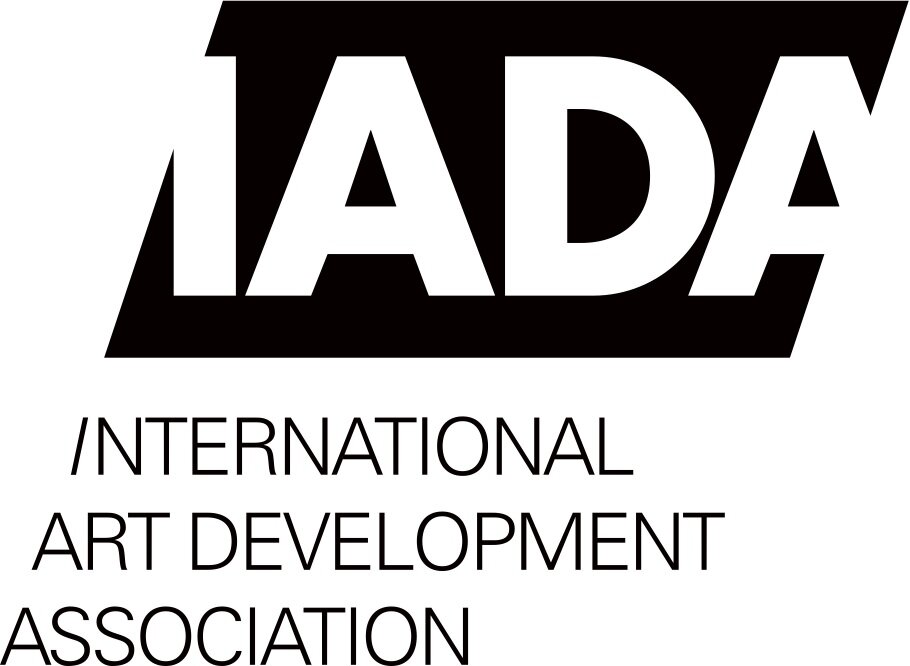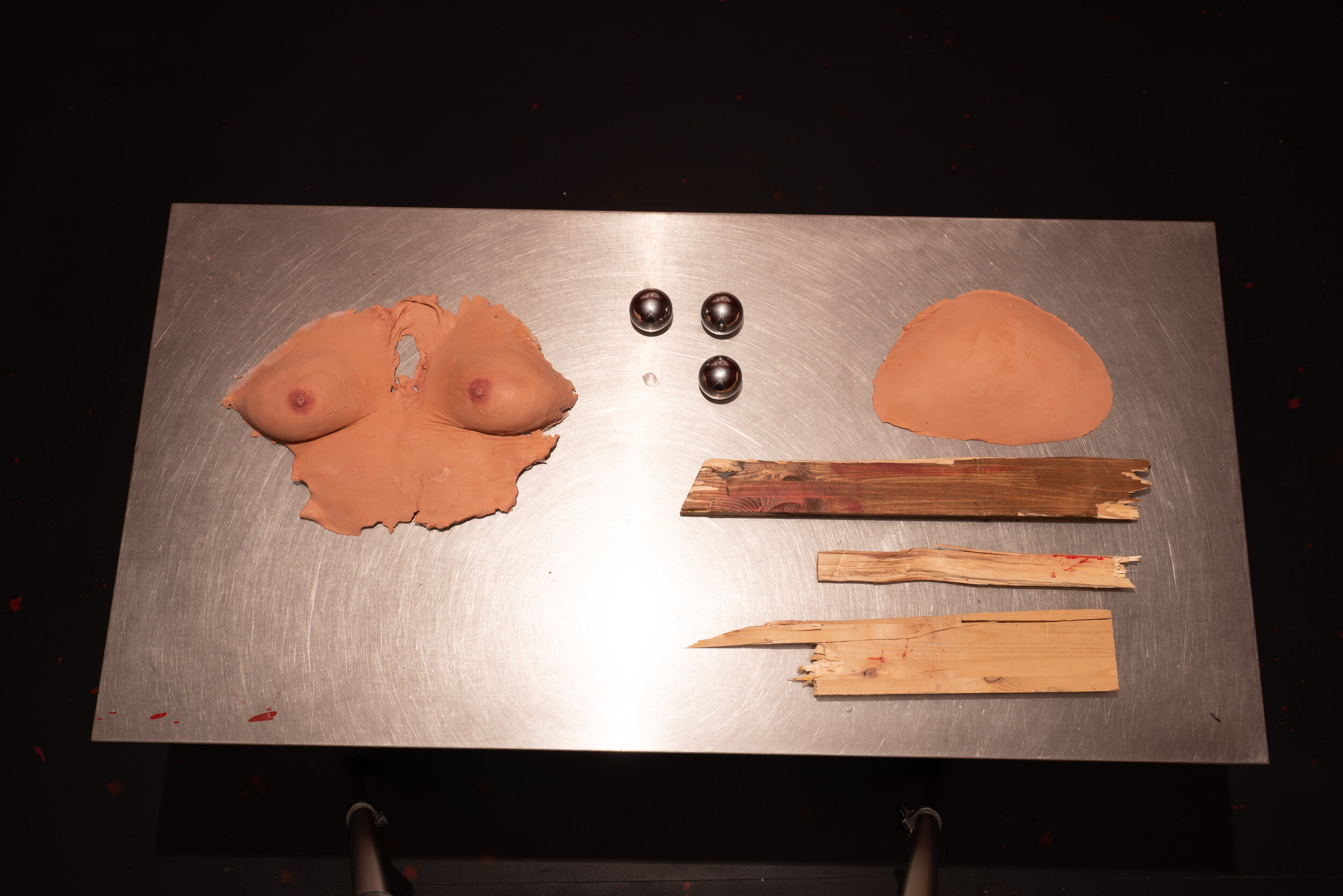Exhibition: First contact
The catalog of young artist exhibition in the program of Astana Art Show 2019
02.06.2019 – 10.08.2019
Curator: Anvar Musrepov
The focus of this exhibition is a new generation of independent Kazakhstan, those who were born during the fall of the Iron Curtain. Through art created by young artists, this exhibition addresses the issue of the experience that has shaped the new generation. Mukhtar Auezov, described the difference between generations as a conflict between the traditional tribal way of life with the new urban culture and secular society in his last novel “Young Tribe” in 1977.
Considering the history of the country as the history of several generations, we can say that the new young tribe described by Auezov, today are parents of the independence age-mates. The memory of all these three generations holds a large reservoir of different cultural layers. In the 20th century Kazakhstan was a country that became a platform for large-scale experiments: a change of social structure and a sharp transition of nomads to sedentary life, the construction of a cosmodrome in the steppes, the launch of a man into space, testing of nuclear weapons. The usual horizon of the steppe closed the industrial constructions marking the progress.
A new generation of artists represented at this exhibition hasn’t met life in the USSR, but grew up in an environment where the trail of slowly escaping Sovietism still exists, where the experience of living in a communist project emerges as a phantom flicker of images about the collective dream of space exploration, portraits of the living and at the same time photos of the dead Lenin. The period of the collapse of the Soviet Union can also be considered as a starting point in the appearance of Kazakhstani modern art. At that time, following a sharp geopolitical impetus and the emergence of a number of new independent republics, artists whose work did not coincide with the ideals of the party came out of basements and close apartment exhibitions. Saying goodbye to the hegemony of social realism, artists began to occupy a special role in the reflection on complex social and political changes.
With the completion of the Soviet project, the end of utopia, which nevertheless has not yet arrived, today we can conclude that a new generation of Kazakhstanis is also a product of this permanent laboratory. Being carriers of hybrid identity, this new tribe is in a certain sense mutants, still retaining the agency of each of the stages of the transformation process.
In the theory of generations, differences between generations are presented as common grounds for a certain age group, of which the authors Strauss and How, draw conclusions about common beliefs, values and behaviors among people who grew up in one historical period. This largely Eurocentric theory considers global historical processes, focusing on the history of America as a universal model, but this approach doesn’t take into account the local as the view of the other excluded from world history. This raises the question of how to present a generation outside the universal concept, seeking to build a harmonious narrative excluding everything that does not fit into it. Answering this question, the “First Contact” exhibition presents a multitude of individual stories that intersecting build a common network like a cloud of keywords. Listening to the voice of each artist individually, you can catch unobvious connections, general semiotics, signs and language that have yet to be deciphered.
Syrlybek Bekbotayev
First Contact
metal construction, mirror, kurt
My work is dedicated to the first contact of different peoples migrated to Kazakhstan with kazakh people.
I created this installation based on a story of a former prisoner of Akmola camp of traitor’s wives, Gertrude Platais. During her arrival from Germany in 1990 she told the “ALZHIR” museum stuff how she first time saw local kazakhs:
Once, women prisoners, under a reinforced convoy, collected reeds on the shore of Lake Zhalanash for the construction of barracks.
Old people and children - local residents of a neighboring Kazakh village jumped out of the reeds. The children at the command of the elders began to stone the tormented women. The guards began to laugh out loud: they say, you see, not only in Moscow, you here, in the aul, even children do not like.
“It was very disappointing and painful,” recalled Gertrude Platais and other former prisoners. This was repeated for several days. One day, dodging the stones flying at them, the exhausted Gertrude stumbled and fell face down on these stones, and she suddenly felt that these stones smelled ... cheese and milk!
She collected these stones and brought them to the barrack. There, female Kazakh women prisoners said that it was kurt - salty cottage cheese dried in the sun. It turned out that in this way, without causing suspicion among the guards, local villagers found a way to share food with the prisoners of the camp.
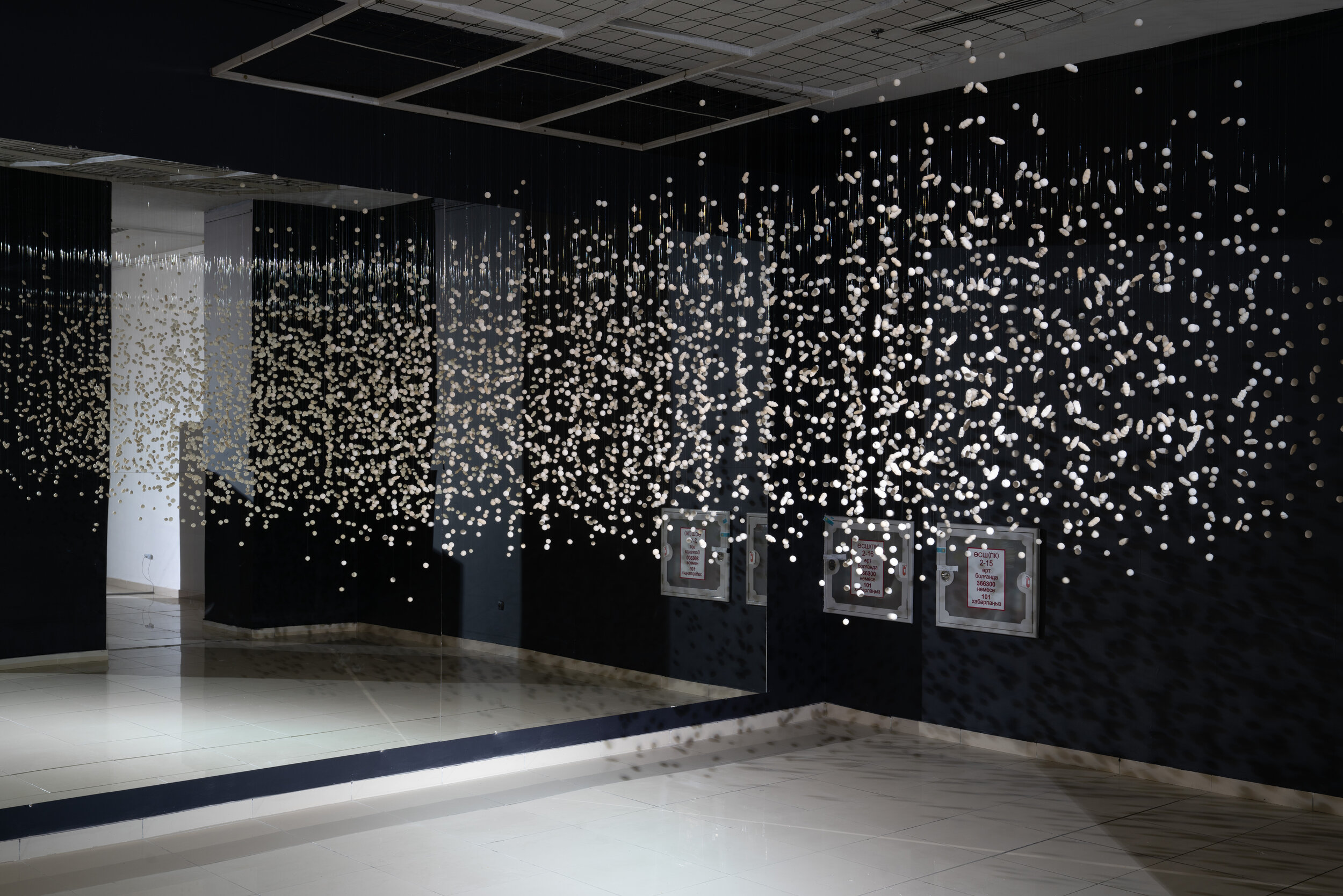
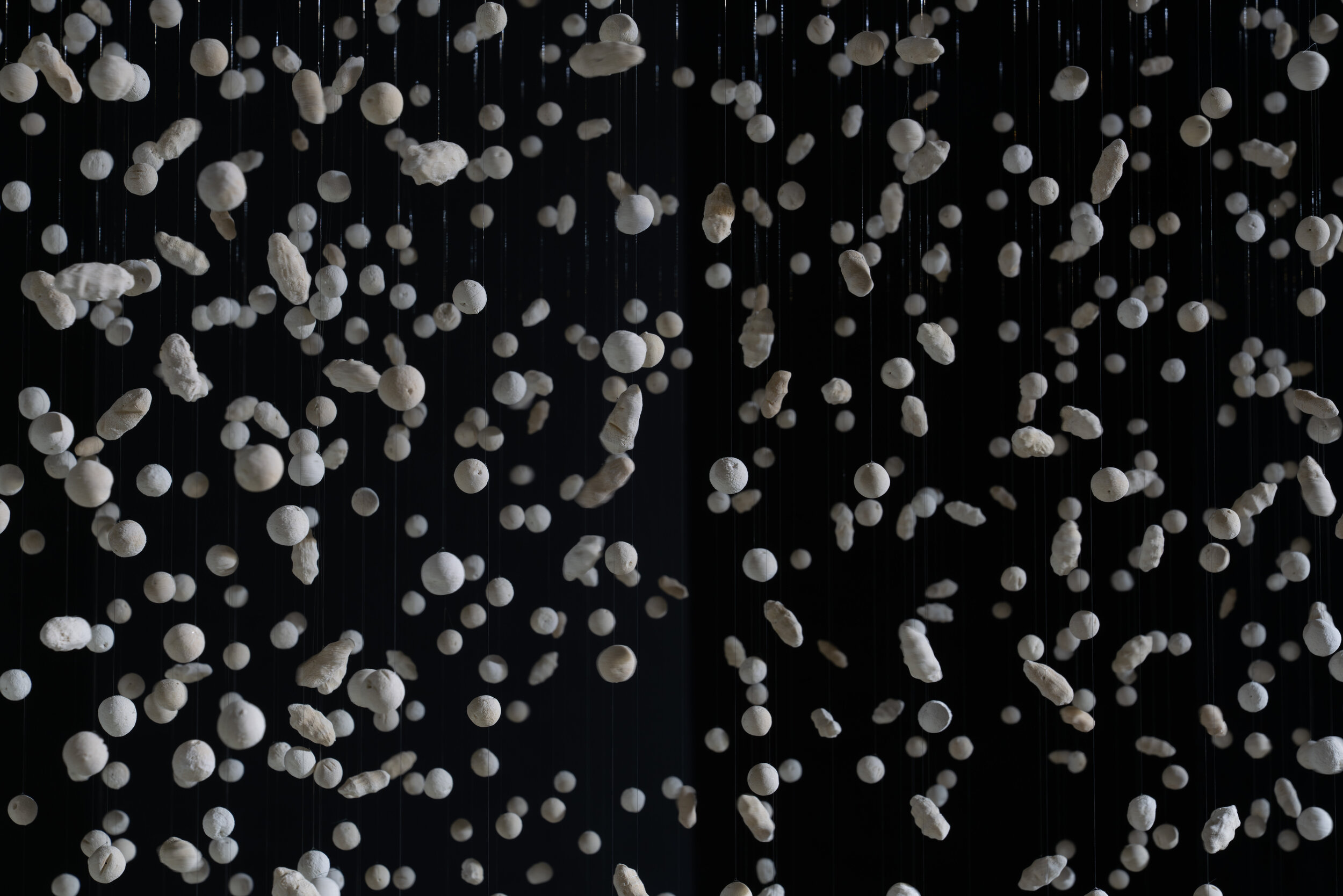
Anar Aubakir
Memory dialogues, 2008-2019
Easel painting, installation, 450x170
The signs and symbols from which we form a language also form part of our perception of reality. We define ourselves, including through cultural affiliation. The culture of nomadic peoples holds a lot of knowledge in the field of literature, science, philosophy and tradition, however, these works are written in the Kazakh language, then using the Arabic alphabet, which today limits access to those texts. With the advent of Soviet power, reforms of the Kazakh language began in order to gradually withdraw it from official use. Books in the Kazakh language written in Arabic for the period up to the 20th century and in Latin in the first half of the 20th century are stored in archives in Kazakhstan and abroad.
Today, the Kazakh language is going through a new, similar stage of transformation - it is moving from Cyrillic to Latin. This practice leads science and literature to zeroing, and breaking generations. New generations will not have access to the history of their people, just as today we do not have access to those archives or cannot understand them. Thus, the accumulated texts for a period of about a century in length, printed in a certain alphabet, are not reprinted when transferred to another, but are sent to the archive.
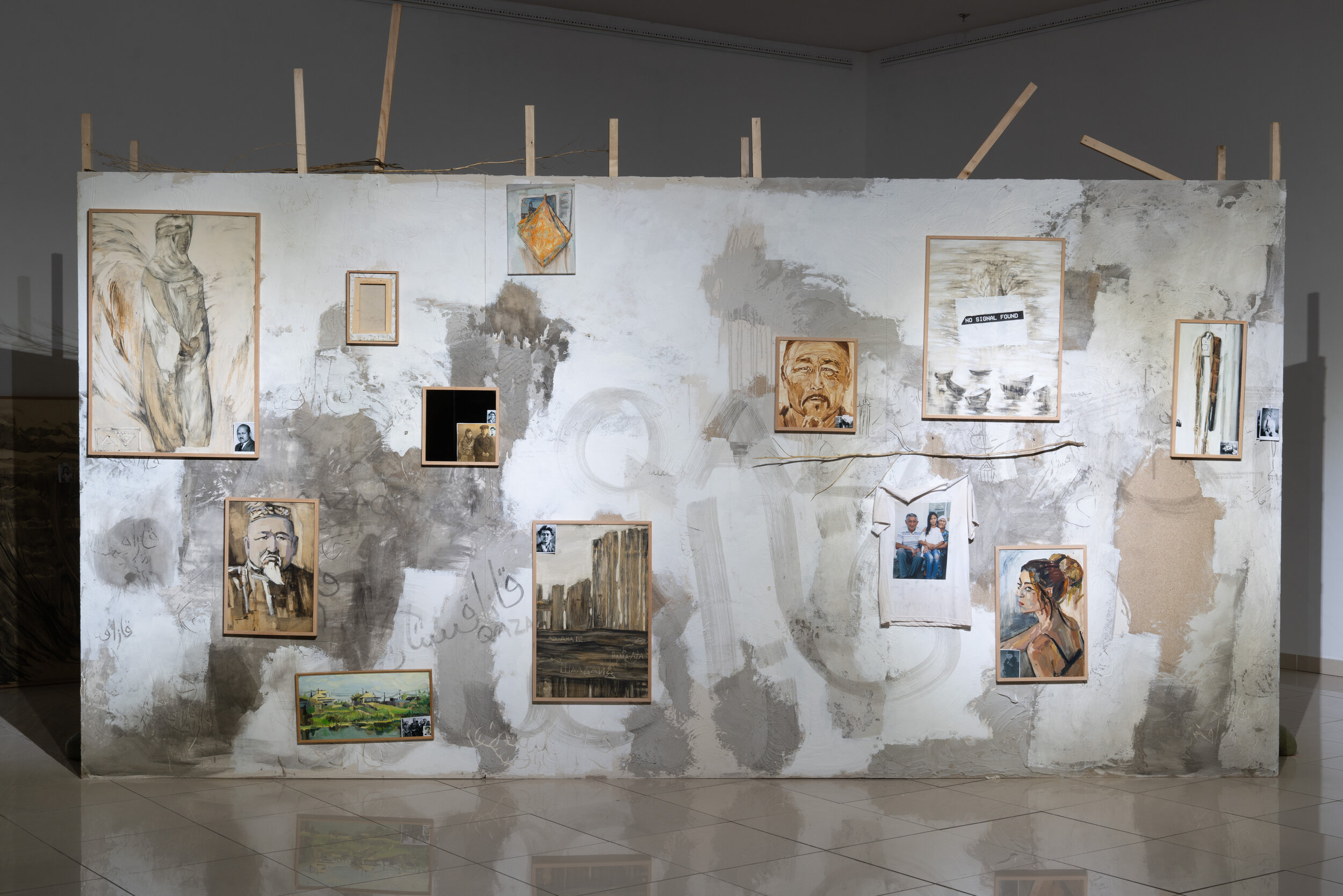
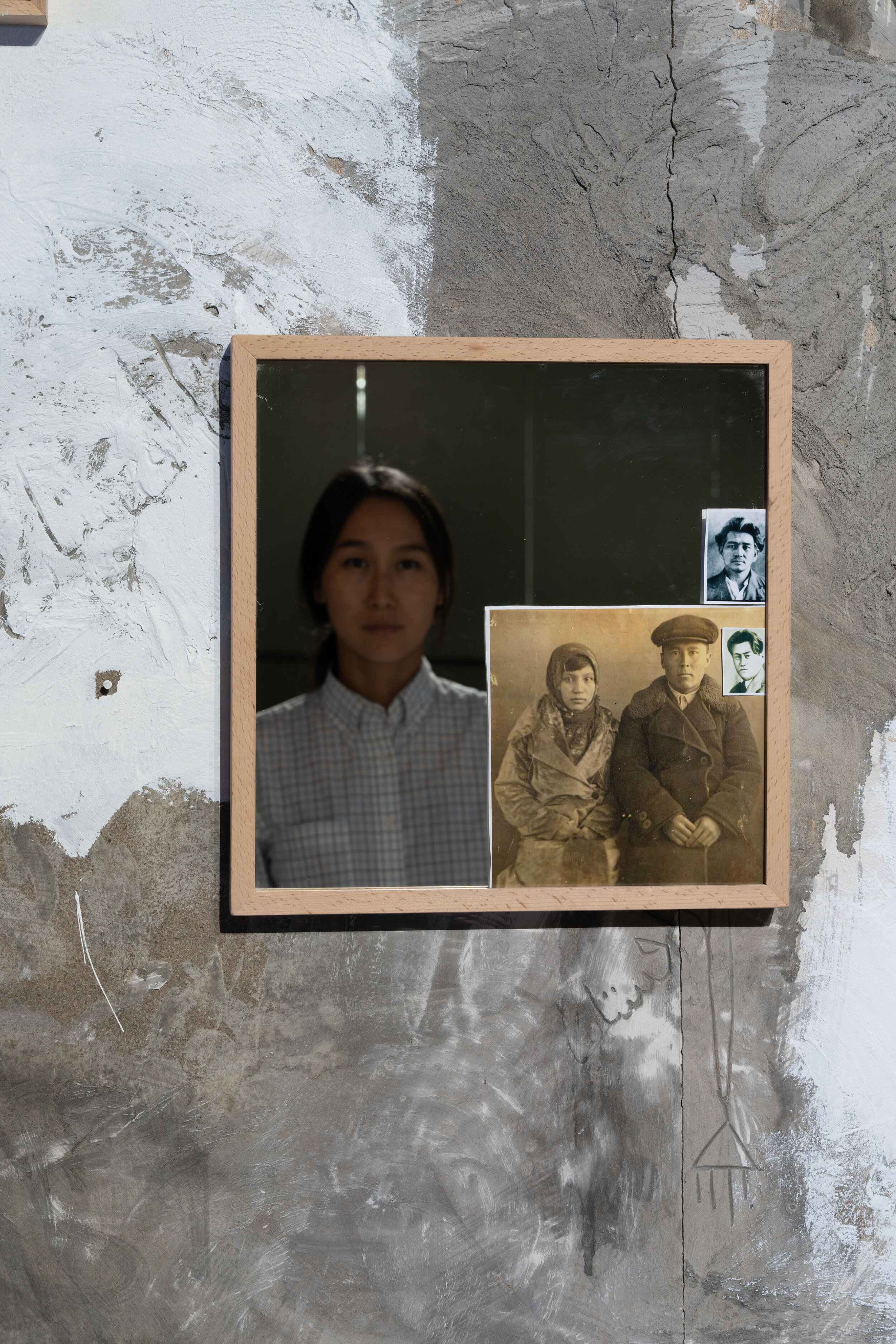
Meruert Kunakova
Fresh blood
Triptych, oil paint, acrylic paint, pastel, 220x160
Once, me and my family went to aul (countryside) to see the Mosque were my great-grandfather prayed, that was my first visit to aul, since I had never left the city. It was so long ago, so I do not really remember any of my impressions of the life in village, but one scene got stuck in my memory forever. That was a dog fight. It seemed like for everyone it was a remarkable event, as people were recording the fight on their phones, laughing, and were very excited about the event.
Everything around was soaked in blood, surrounded by the rumbling crowd there were exhausted and torn-apart dogs, in whose eyes there was fear and confusion, at the same time with violence and fury. Still, I cannot erase that scene from my memory. Then, I made several sketches, I remember that as a flicker, as I kept turning away not to see, but looking again to continue the sketch.
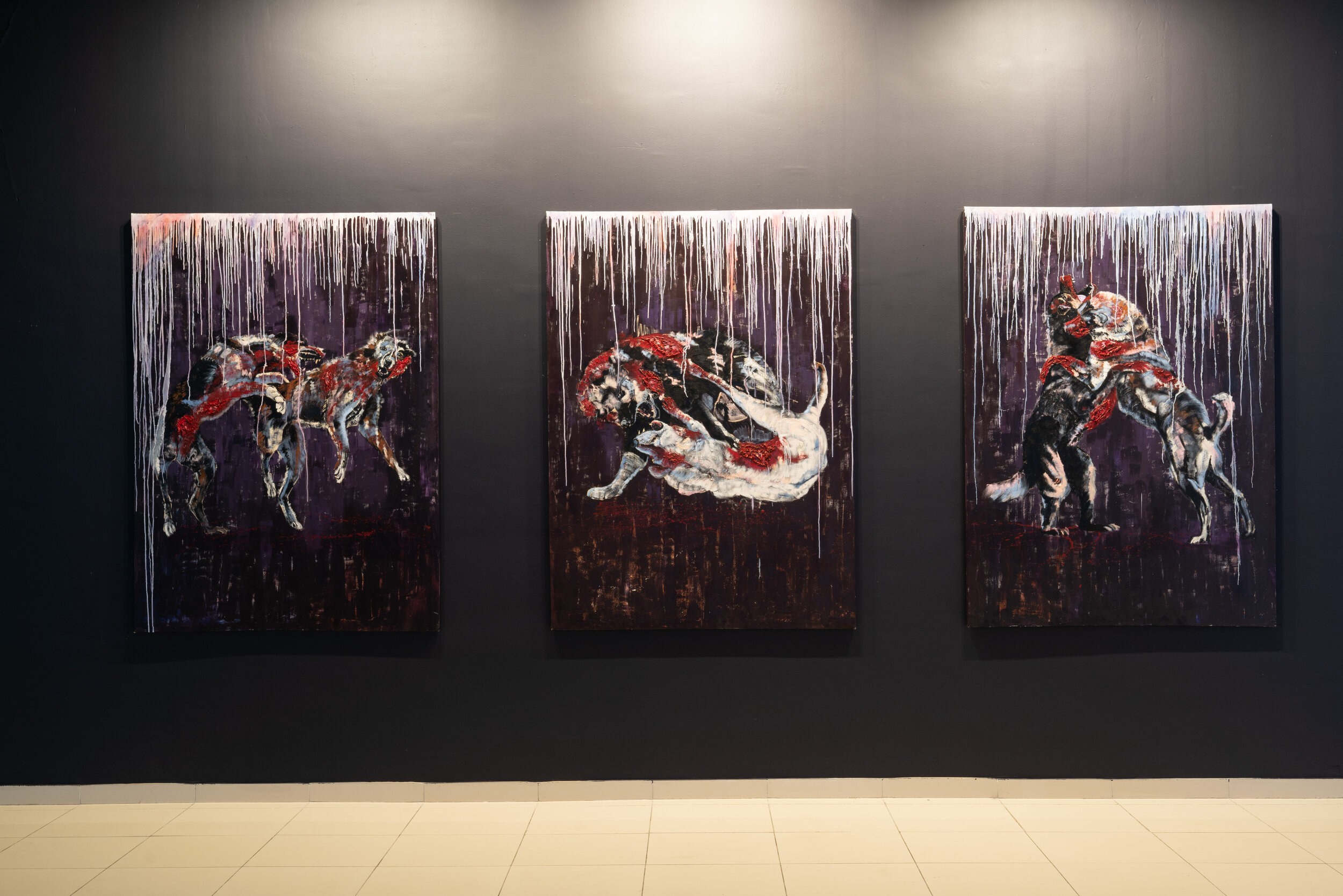
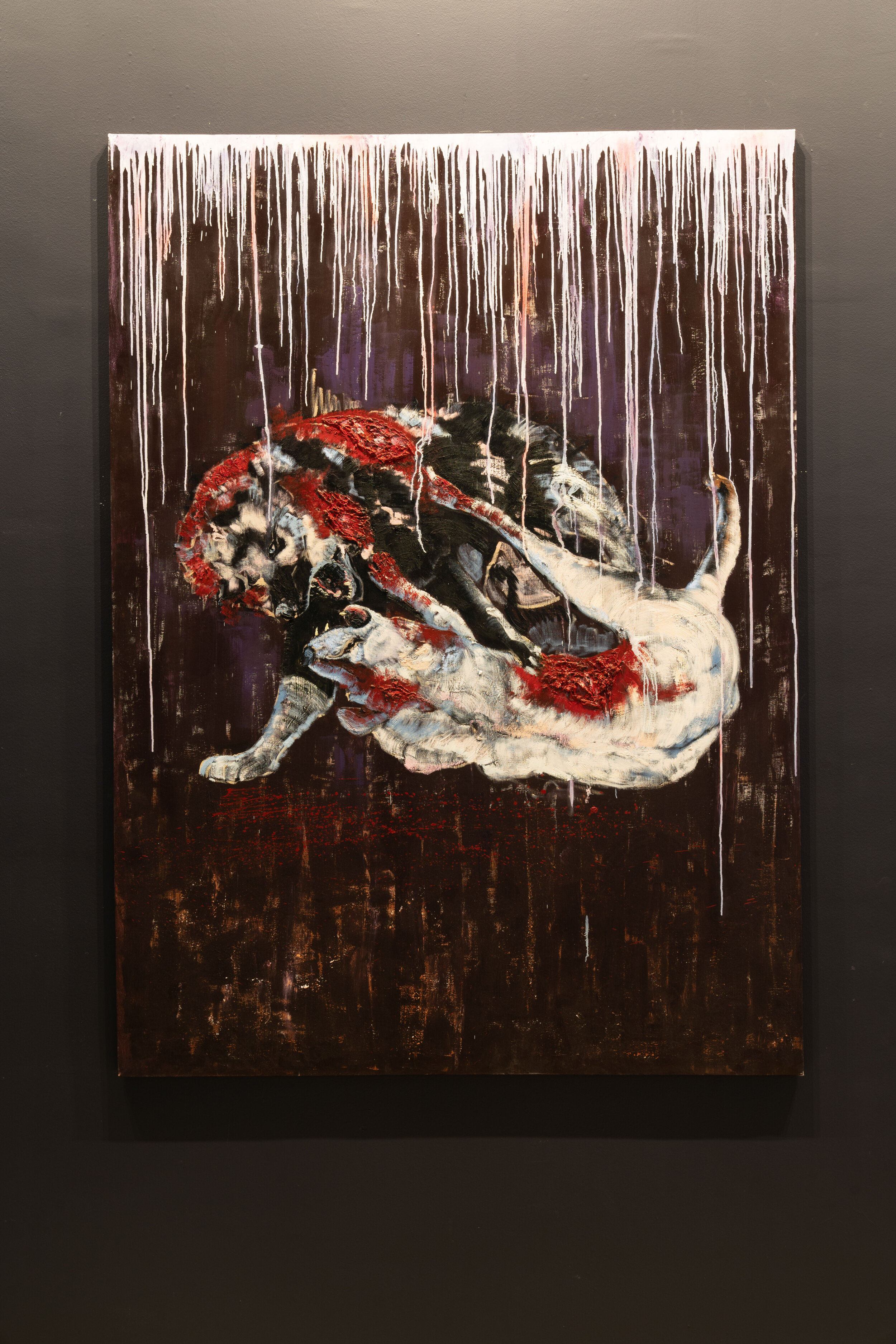
Medina Bazargali
Within the law
Programming, printer, a small architectural form
Inside this installation, the viewer is in a twofold state: he experiences physical discomfort inside the crushing space and remains face to face with the all-consuming machine, which stamps the material evidence of its strength. In this space, the social “I” of a person is reduced to a simple piece of paper / file / case / sentence.
The repressions that took place in the last century reflected the consequences in the modern world, tens of thousands of people today are descendants of political prisoners, and throughout the post-Soviet space there are numerous monuments of cruelty - the former buildings of the NKVD. They all resemble each other, thousands of identical cells, punishment cells and interrogation rooms. These disciplinary spaces are an integral part of the institution of fear. Fear of a system that dehumanizes a person to a numerical value denoting the case number.
The project consists of several major part:
- a soundproofed claustrophobic punishment interrogation room, he parameters of which correspond to the psychologically pressurizing back rooms of the People’s Commissariat for Internal Affairs.
- neural network, trained of civic, administrative and criminal codes and constitutions of all dependent countries of the former USSR;
- the imitation of the external evaluation of the gender and age by the police, with the consequent insinuated label in the protocol about the concealment pf personal data;
- personal file.
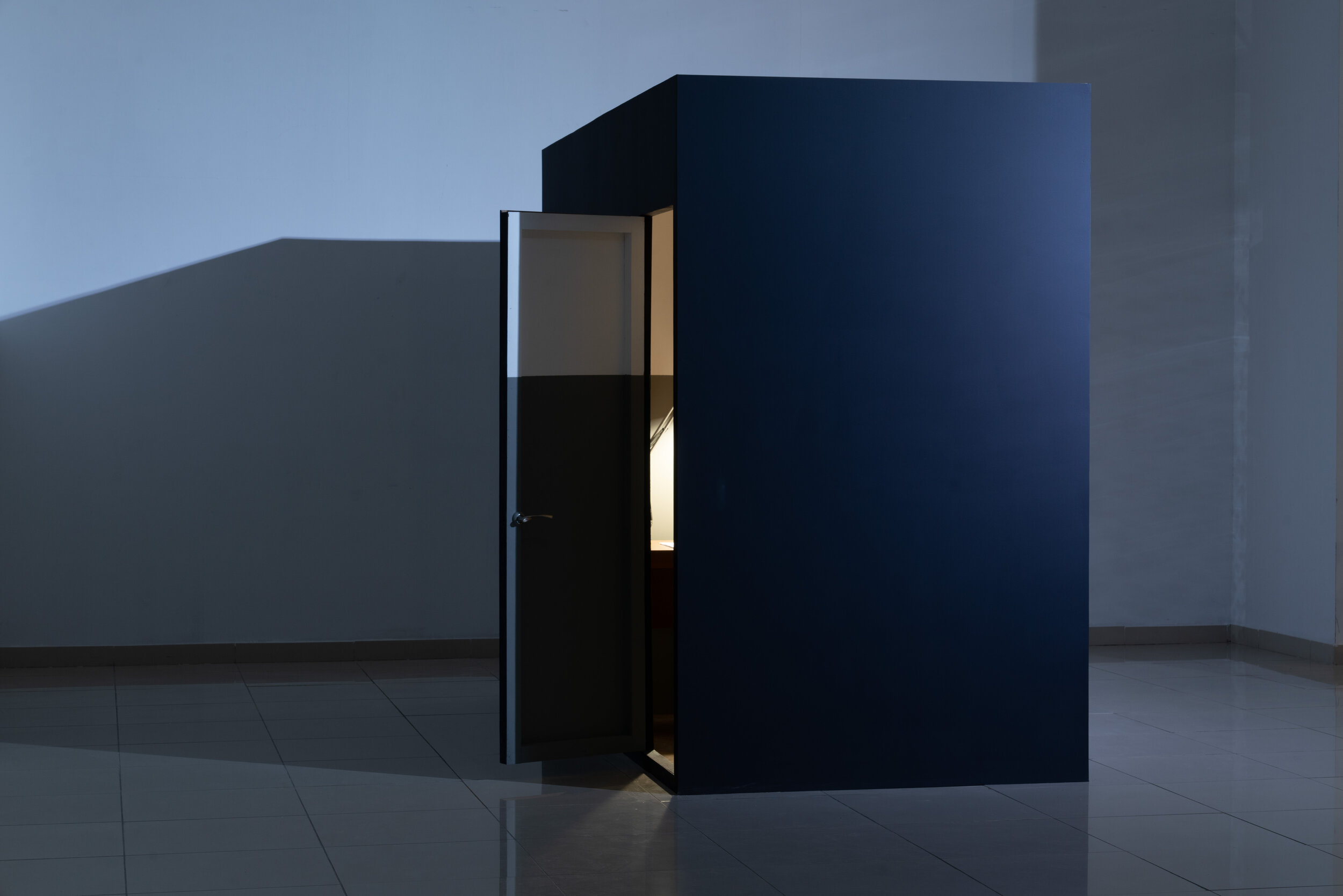

Daria Trofimova
In-between World. Part2
Two-channeled video, photoprint, the artist’s personal archive
In the work “In-between World. Part 2” Darya Trofimova speaks about her hometown Pavlodar. The city, located on the border of Kazakhstan and Russia, was founded as a border outpost, and found its “second wind” during the years of wilderness development (tselina). A massive construction started, as the workers of new factories needed accommodation. In 1955 first mechanized columns of builders, amongst whom there was the artist’s grandfather, who moved to the North of Kazakhstan in the beginning of 60s. He worked in a city construction company as a crane operator, and built five-stored houses, in one of which he lived with his family.
“In-between World” is dedicated to the relations of two bordering countries, that existed for a very long time in a discourse of imperialistic colonialism. The traces of such interaction can still be seen in the city organization and architecture, as the city landscape is fully freed of the local cultural significance. Two spaces are faced in the work- historical-political and personal, biographic, as a hidden cultural zone is exposed. Through elements of an autobiography, a family archive, installations of things that the family has accumulated over the years of life in an apartment in one of the five-story buildings, the artist analyzes the search for her own identity. She explores the connections between collective and personal memory, conceptualizing postcolonial consciousness.
Sonata Raiymkulova
Sample №0206
Installation, 2D animation, mapping
People, as houses where they live, do not tend to change a lot. I was born where, there are small five-stored houses, with the same planning and similar windows. Wherever I saw such houses, they always reminded me of my home and created cozy atmosphere. Nowadays, they are being demolished and displaced from our space, implying that their time is out and the world is moving in an absolutely different direction. Poor houses, getting more and more lonely, trying to get used to the cold and prudent environment.
Aigerim Ospanova
Shai-pai
City intervention-kerege (wooden basis of a yurt), korpe (traditional cushion and mattresses with patchwork embroidery), video documentation, interview recordings, cartography of movement
The intervention gets all over the context of the city, and creates the situation for new communication scenarios. The form, wondering around the city, made of elements of traditional life of the Kazakhs, selects venues that are not conventional for kerege (the basis of a yurt) to be installed, such as Population Service Centre, the department of the Migration Police, a bus stops in a residential area, and offers people to be a part of the art project. The dialogue focuses on the understanding of hospitality as a socio-cultural phenomenon, they share practical pieces of advice on guest reception, and how responsibilities are divided basing on a gender. On an intervention held outdoors – uncontrolled courses of scenarios can take place, through which social gaps get activated, and wishes and needs to be heard and able to speak up can be seen.
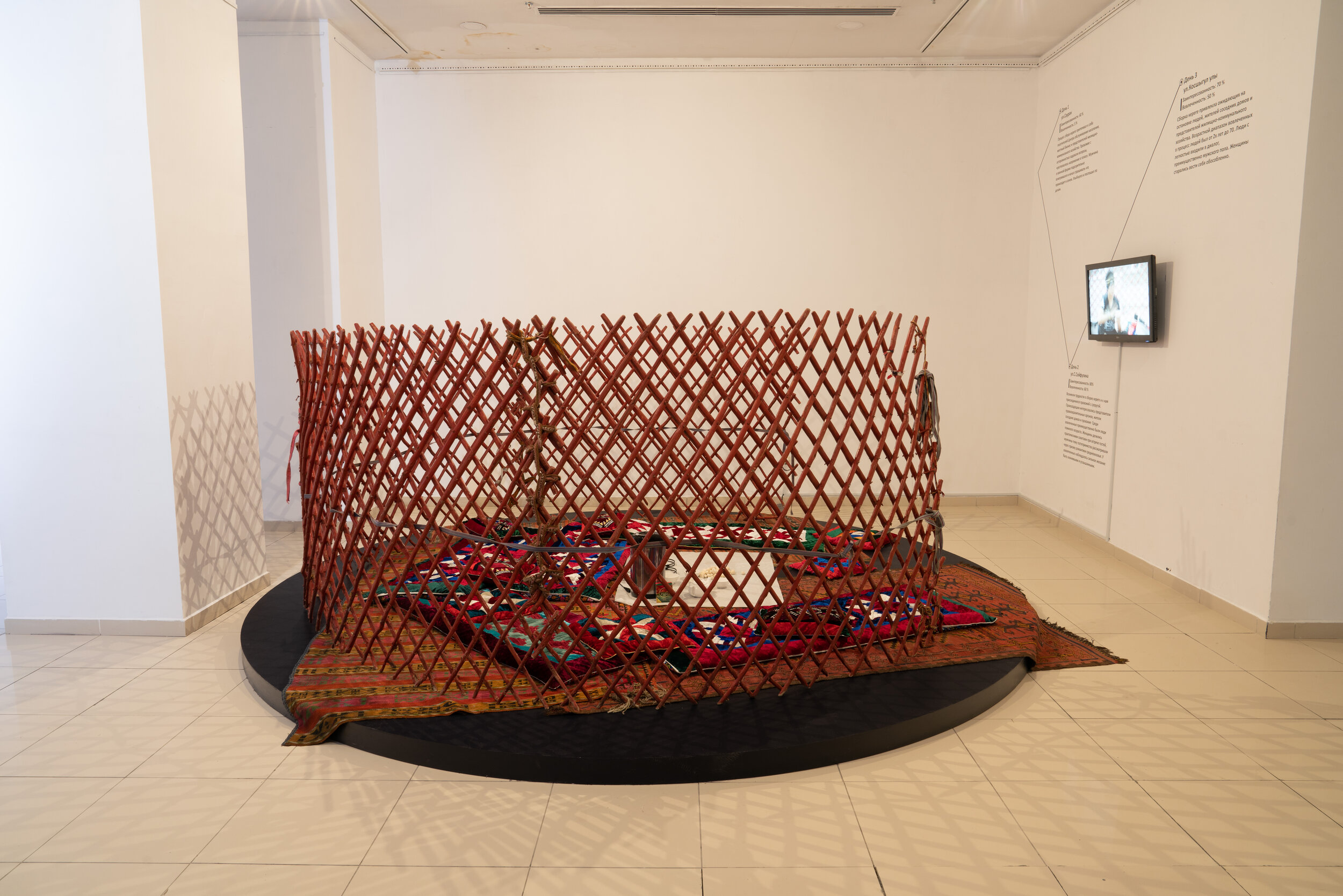

Nazira Karimi
Return Policy
Installation, dresses, concrete, interview recordings
In the countries of Central Asia power at within social institutions belongs to men. The influence of the patriarchy on society is significant, and it is not difficult to find examples of these structures.
In a conservative society, the image of the woman reflects cultural obsessions and interests of this society. Some of these cultural categories are used as a framing tool by which society accepts and agrees on the principles of female existence. It is simplified to the relationship between owner and ownership; subject and object. Sacred rituals allow to bring, take away or return a woman deemed unsuitable.
In my work, I appeal to the wedding traditions of Tajikistan. For that i used 40 national dresses. 40- is one of the most significant symbolic numbers in many cultures. 40 days after the wedding, the girl should wear 40 different elegant national dresses.
Aigerim Akenova
OYU
Multisensory immersive installation, fabric, recycled clothing, foam
Touches/textures, fragrances and colors are the main guides of this installation. Made in the technique of Kurak korpe this textile installation refers to one of the oldest symbols of the feminine - to the shape of a rhomb. The meaning of the rhombus - in geometric ornamentation - is a sacred element that symbolized fertility, femininity and protection from evil spirits.
Being together brings people feeling of closeness. The central part of the work also becomes new scenarios for the development of relationships between people.
Based on research, which began with a rapid response in the social networks on “UMAI” from the collection of the brand AIKEN, conceptual designer Aigerim Akenova explored the emotions and feelings associated with self-acceptance: vulnerability, fear, shame and courage.
An important part of this work is also social interaction - to create this work Aigerim collected things from people, in order to create an installation of them, keeping memory of the individuality of people who once wore it.
To create this work, Aigerim conducted a study, part of which was a survey to identify the colors, textures and flavors associated with people in a state of “vulnerability” and “courage.”
Information about the composition of the fragrances, which are also part of the installation and created specifically for this work:
VULNERABILITY Crude, Easy (survey)
Ingredients: Bergamot, Lavender, iris, Oak moss, Vetiver
COURAGE Bright, Fresh, Tart
Ingredients: Mint, Pomelo citrus, rose, Sandalwood
According to the results of social surveys were identified:
Vulnerability:
color - pink, peach
texture - fragile, light
aroma - raw, light
Courage:
color - red
texture - hard, smooth
aroma - bright, fresh, tart
Aruzhan Zhumabek
Untitled
Silicone, metal table, aluminum balls, wood
Dismemberment of human body as dismemberment of memory.
To dismember and assemble it into a composition, to have power over it. To put experiments on self-memory, spreading it on the medical table. Parts of human skin as a part of tactile memory which remembers everything that our brain would like to block. The skin can absorb everything and store it for many years. The interaction of the skin with the substances not compatible with it.
Metal - the implantation of cold and hard substance into warm flesh, stretching it.
Wood - rough and at the same time gentle, warming texture full of life.
Rinatto Lbank
FLOW/ÕZEÑ
Installation-sculpture, gypsum, ponoplex, metal
Volkova Evgeniya - photographer;
Dusembayev Akhat - sculptor;
Murzagulova Altynay - sculptor;
Voronchikhin Alexandr – colourist.
Continuing to develop his own visual code in this project of a total installation, Rinat turns to a sculpture as a material form by transferring images from the screen plane to three-dimensional space. The process of mutation and transformation is one of the central ideas of the artist’s creativity. Using prisms to refract light in graphics programs, the artist creates a simulation effect of the density of water, also uses the images of human bodies as material for the creation of new composite forms.
Sabina Kuangalieva
FUTUROSTAN
Interactive installation, VR game
The mythical space of this Game has symbolic, but unexpected and empty markers of a fake identity. Architecture has always been a long-playing archive of images and meanings, but in our case, the entire space between these structures are missing, the game is not finished and there is no importance if the space inside this simulation collapsing or it is detailed and realistic. Heidegger argued that the world is ontologically incomplete, and myth about our new identity is constantly going through a metamorphosis and it cannot be "done". The reality created not by the player and not for him but he placed in it, the player is forced to wander horizontally at the place that was proposed to him vertically. The endless expanses of the great steppe have no difference from the empty render, which any game simulation starts from. The place is a white sheet and anything can be designed on it, and therefore so hard to end it up. The game is non-linear and has no ultimate goal. It is impossible to lose as well as to win. It is a metaphor for Supreme stability.
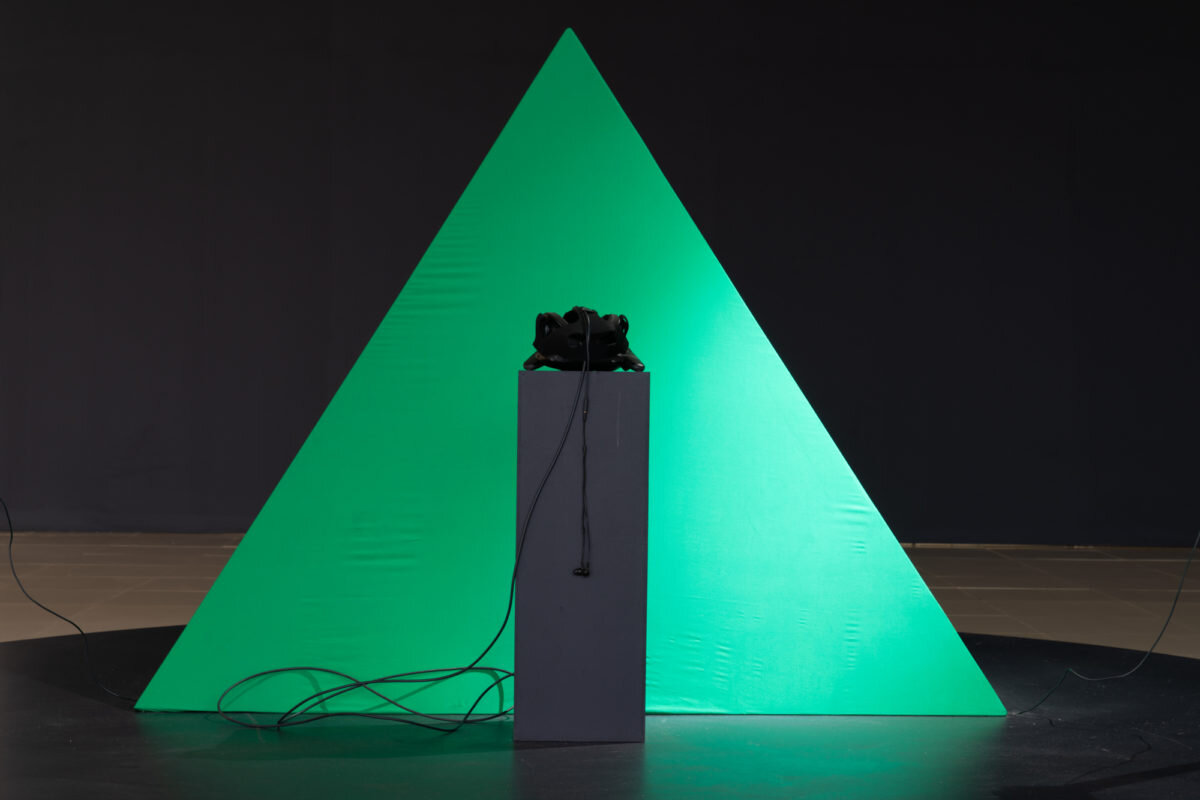

Aitegin Muratbek uulu
OUO (Operational Universe Oscillator)
Six-channeled audio installation, arduino, pulse detector.
Place your thumb to the sensor for 4 seconds to interact with the installation.
There is a pulse sensor in the center indicating the pulse of heart rate of the person who places a thumb on the detector. 6 audio channels create an environment that reacts to the heart beat rhythm of every new user. The composition changes depending on the rhythm of your heart rate, creating a collective body through the sound, by overlapping every new signal. The heart pulsation in this work is considered as a part of the universal oscillation.
Gaisha Madanova
Beam me to the Presence
Light installation, variation-2, (encoded message into a Morse code light signal)
In 1877, when the Italian astronomer Giovanni Schiaparelli drew the first detailed map of the planet Mars, he imagined it as an earthly paradise. He named regions Eden, Elysium, Arcadia and Utopia, the latest in honor of Thomas More. In 1976 the spacecraft Viking-2 landed exactly on Utopia and began exploring Mars. In 2014 the private company Uwingu Fund, founded by astronauts, scientists, and former NASA personnel encouraged “the inhabitants of Earth to send personal messages and pictures to Mars by radio transmission”. 237 messages were selected and sent — at the speed of light — as a global shout-out from Earth. These texts express a human desire for exploration of unknown and undiscovered territory. The authors show their hopes and faith into the possibilities of passing frontiers to a new world, a new chance to make everything right. They wrote messages that carry the potential of being the first significant words to start a new communication, facing the risk of being lost on the way and never to be heard. This work is based on one of the thousands of messages that were originally submitted. The installation encrypts the text with the honest hopes to Morse Code light signal that through the optical radiation of photons gets another chance to exist in space.
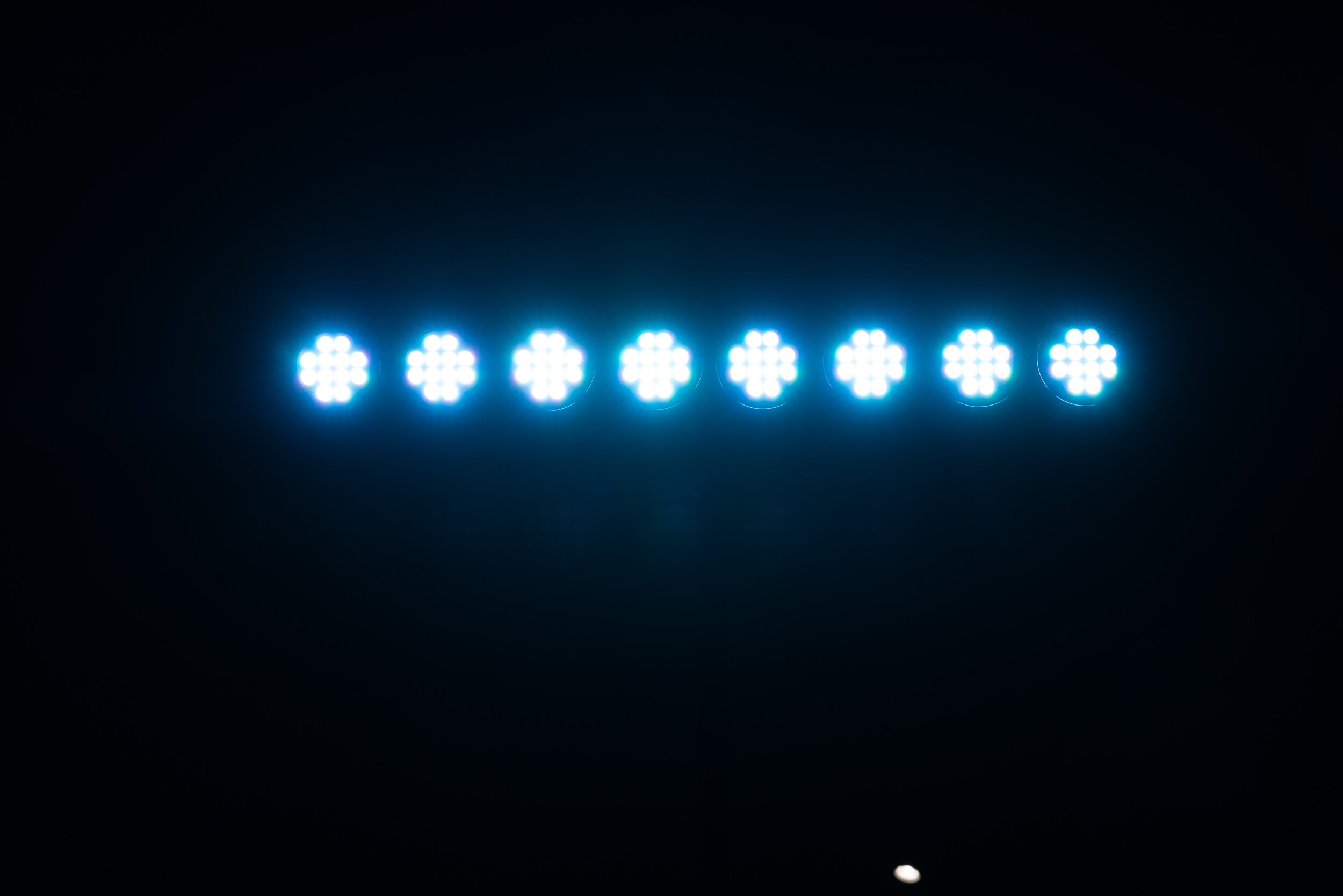

Bakhyt Bubikanova
Stigma
Two-channel video projection, disco ball
Voice: Rufiya Dzhenerbekova.
A close claustrophobic space, where a spectator meets Betty Boop, the character of an American animated show of 1930. In 1934 the Hays Code, the set of rules on the censorship of the American cinematography, was enforced. The character of the second half of 1930, is no more a sexual and free young woman, but a single housewife. The self-censorship of the authors leads to the end of the show, as Betty changed a lot and was no more adored by many. The projection covers the whole space, including the body of the person who entered the room, subjugating by it’s power, in psychedelic paranoia, moving from a tender flirt to direct threats.
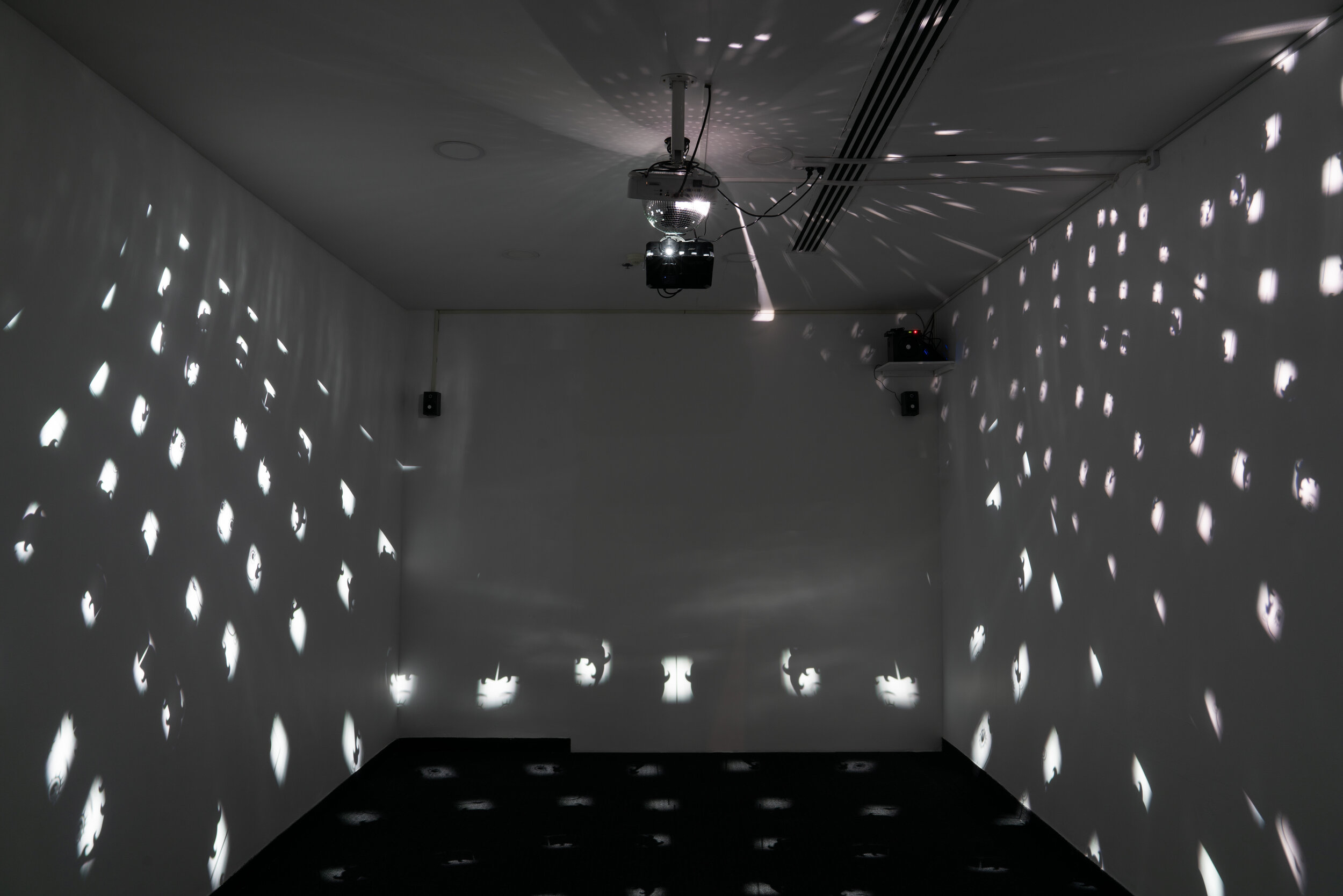
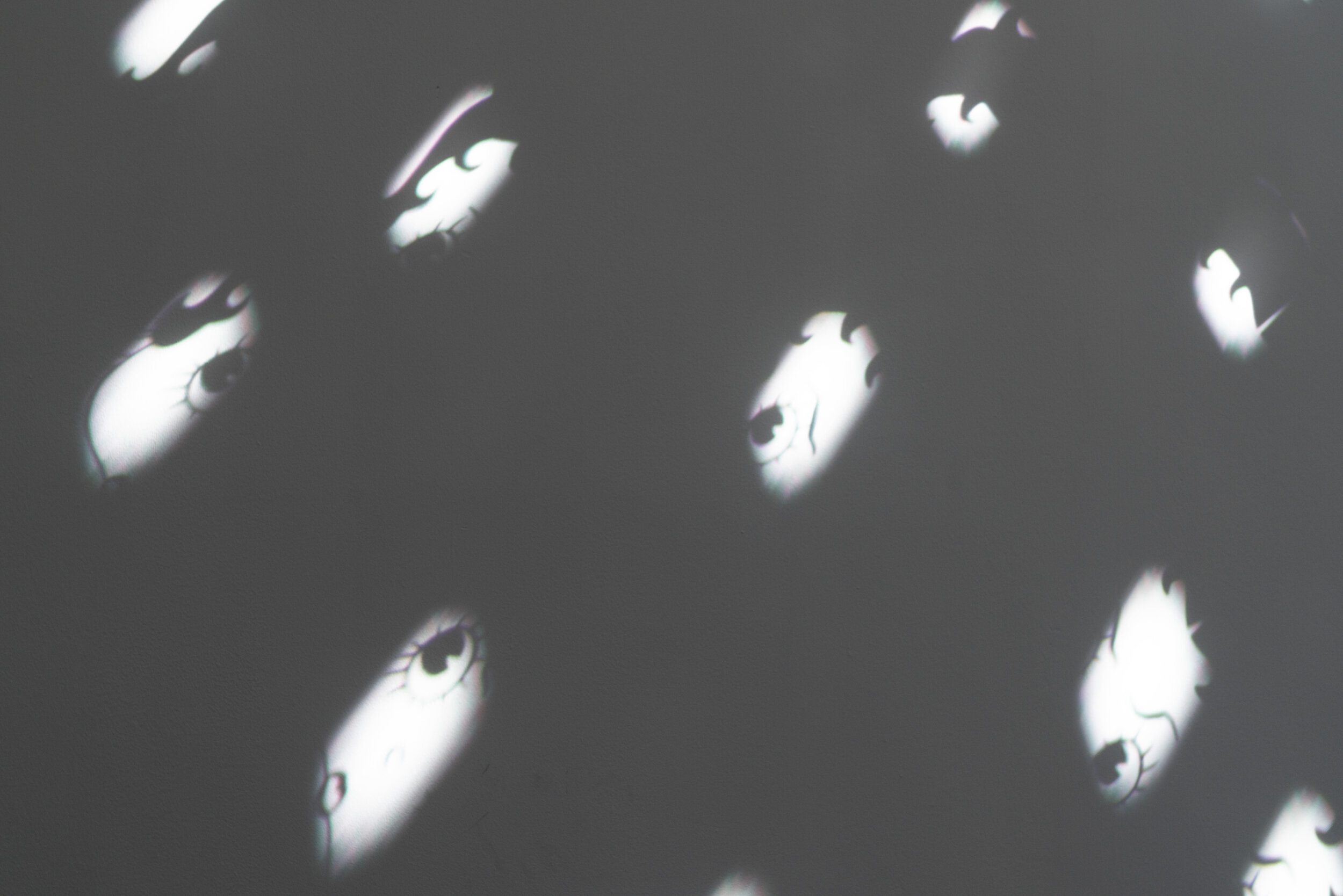
Marat Dilman
Swan migration
CGI graphics, reverse projection tape, sector antennas
When the reality contacts with the virtual world, it inevitably goes through a transformation, acquiring new dimensions and setting its own rules. The world, nature, people’s behavior and interaction – nothing remains the same. The flow of data in which our ides are being digitalized, substitute the reality as well as influence on the nature of the original. In this work the author speculates on the topic of virtual reality and means of communication, that unite communities, and at the same time fragmenting them. The author compares the free transmission of wireless data to a free swan migration. However, just like the freedom of speech and actions in the net, their movements are limited by two antennas showing them direction.
Arman Sein
Triptych on Myth, Movement and a Song
documentation of performance, generative sound, flagpoles
Abstract:
The composition consists of three parts indicated in the title. All of them are united by a common element in the form of an act of creation of political reality. In the part “Myth” you can see the video documentation of the General strike - flag bearers of creation - the basic political myth, designed to consolidate the group at the first stage of the movement formation. The party “Movement” is a floor scheme of the myth spreading in the normal political environment, the viewer is given the choice to stand in any of the designated subsets. The party “Song” in the form of “Ode to joy” on the synthesized dombra sounds solemnly from the speakers and waits for its ideological impregnation.
Part 1. Myth
Political myth does not have to be realistic, it just needs to be internally consistent. More times than not it is very similar to the religious doctrine of the creation of life from the primordial chaos, leaving space for all possible scenarios in the future, whether it will be the mythical end of the world/regime or the arrival of the Savior/Creator. In most cases, the political myth is a myth of the unity, the beginnings of intersubjectivity between the atomized members of society, the creation of a national state. Myth is archaic, but this does not prevent him from dictating the rules of the game in political reality.
Part 2. Movement
The new paradigm of political science combines discursive approach to ideologies and dialectical distinction of attitude toward the objects in the categories “beautiful — ugly” and “sublime — low”. Kant in his “Critique of Judgment” described sense of the sublime as some combination of admiration and fear in the face of something greater than you. He also spoke about two types of harmonization that are evoked by this sense: the harmonization of the inner and the outer worlds and intersubjective sensus communis, the basis of the group identity and statehood. I am talking about the enemy who triggered the primitive sense of fear and the instinct of inner-group cooperation in our ancestors. And exactly the wars between enemies developed our morality and necessity to care about each other. The enemy stood at the origins of nationality, and my hypothesis is that the enemy is an aesthetical category. To inspire the fear, the enemy should be infused with either sublimity or lowness (colonizers trying to absorb Us with Their technologies vs barbarians eating their own children). Carl Schmitt in “The Concept of the Political” wrote that political is, in the first place, the distinction between me and them, between the human and the alien.
The symbol underlying my myth demonstrates this hypothesis. The scheme on the floor, borrowed from Hannah Arendt and modified, indicates the direction of the myth movement in the “normal” society. Political myth necessarily carries new linguistic constructs, new binary oppositions. Posing as some dark force, the group carrying the myth to the masses overcomes the path of normalization of its special language.
Part 3. A Song
Song, or more broadly music, was one of the first mediums to coordinate human activity among themselves. Collective labor, which required the synchronization of several individuals, was performed much more effectively when people felt bound by something more, even with the simplest whistling. This political technology is thousands years old and it has traveled the path from ceremonial-religious and military functions, as well as drum march to maintain the tempo of the slaves moving. Such a simple mechanism, because of the availability for the subconscious, is used everywhere today.
The final part of the triptych uses the main theme of Beethoven's 9th Symphony. The author found post-Napoleonic desire for progress and brotherly-sisterly unity of all people in the sound of his piece. As Zizek noted, " Ode to joy” appeared as an unofficial symbol in almost all major ideologies: from national socialism, communism and Maoism to the fact that it is the current anthem of the European Union. Its universalism is emptiness. “Ode to joy” is an empty container, an empty egg ready to be impregnated with any credit and values, wherever the Myth and the Movement can lead.
Katya Kan
Love is
Micron pen and ink on paper, 239 x 91
“Love is” expresses a surreal utopia of a romance between mythical rabbit and fox characters from emotional and political viewpoints. It uses Katya Kan’s exposure to the collapse of Socialism in Kazakhstan in the late 1980s and beginning of the 1990s as its backdrop when her family unit was complete and wholesome. The scene is set in Tamga: a village near the Issyk-Kul Lake in Kyrgyztan with a former Soviet military camp, where Katya used to go on holiday as a child. Where the rabbit character is embellished with Marxist hammer and sickle emblems, the fox character has Viking symbols, conveying the Western ideology. The two characters fuse these two worlds that Kan lived in together: post-Marxist Kazakhstan and the laissez-faire, moderate, capitalist state of the United Kingdom, where she lived from age 10. The title “Love is” is based on a Turkish chewing gum, which was popular in Almaty, Kazakhstan when Kan lived there between 1995-1997.
